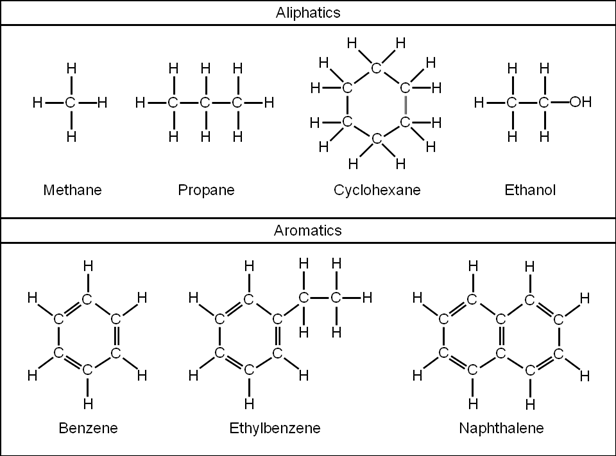Extractable Petroleum Hydrocarbons (EPH) may be invisible, but their impact on the environment is tangible. Through advanced monitoring techniques and a robust regulatory framework, we strive to strike a balance between our dependence on petroleum products and the preservation of our planet. But what are they & how are they monitored?
Extractable Petroleum Hydrocarbons (EPH) are composed of aliphatic and aromatic hydrocarbons. Aliphatic compounds are usually linked together in chains via single, double or triple bonds. In structure, they can be linear, branched or cyclic. Aliphatics are broken down into 3 categories: Alkanes, Alkenes and Alkynes. By contrast, aromatic compounds are always cyclic molecules and contain alternating single and double bonds. Aromatic hydrocarbons also go through a type of chemical bonding called aromaticity, giving them distinct stability and reactivity compared to aliphatic hydrocarbons.
The graphic below shows a graphical representation of aliphatics vs aromatics. Each of the aliphatic examples contain single bonds and are linear except for cyclohexane. The aromatics all have distinct benzene rings with alternating single and double bonded Carbons.

EPH Monitoring
Real-world understanding of EPH contamination begins with proper sampling. Soil and water samples collected from potentially contaminated sites provide critical data for laboratory analysis. Monitoring petroleum production wells further enhance our understanding of the migration of EPH in the subsurface, aiding in targeted remediation efforts. The table below shows the sample handling procedures taken from the Massachusetts Department of Environmental Protection (MADEP) EPH Method of 2004, which is the original EPH published method from which all other states/regions crafted theirs.
|
Matrix |
Container |
Preservation |
Holding Time |
|
Aqueous Samples |
1-Liter amber glass bottle with Teflon-lined screw cap |
Add 5 mL of 1:1 HCl; Cool to 4 ± 2° C |
Samples must be extracted within 14 days and extracts analyzed within 40 days |
|
Soil/Sediment Samples |
4-oz. (120 mL) wide-mouth amber glass jar with Teflon-lined screw cap |
Cool to 4 ± 2° C |
Samples must be extracted within 14 days and extracts analyzed within 40 days of extraction |
|
4-oz. (120 mL) wide-mouth amber glass jar with Teflon-lined screw cap. Jar should be filled to only 2/3 capacity to avoid breakage if expansion occurs during freezing |
Freeze at - 10°C in the field or in the laboratory*. |
Samples must be extracted within 14 days of the date thawed and extracts analyzed within 40 days of extraction. |
* Samples processed in the laboratory must be preserved at 4 ± 2° C and frozen within 48 hours of the time of collection. Frozen samples may be held for up to one year prior to analysis and must be extracted within 24 hours of thawing.
As you can see from the table above, the MADEP EPH method prescribes amber glass containers with Teflon line caps for all sample types (Aqueous, Soils/Sediments). Glass is a chemically inert compound and its use, versus plastic, will ensure that it does not react with the sample. In addition, since petroleum hydrocarbons are the building blocks for creating plastic products, it is important to minimize any potential for leaching of plastic material from the sample container into the sample. If plastic material leaches into the sample there is risk for a false positive in the final result . The addition of HCl to the aqueous samples serves multiple purposes such as: lowering the pH to preserve the stability of the petroleum hydrocarbons, the inhibition of microbial growth and increasing solubility of certain hydrocarbons to make them more accessible for extraction and analysis. It is important to store the samples at cold temperatures to minimize loss of the more volatile compounds and minimize the risk of oxidation. Finally, extracting within 14 days of collection is key for maintaining regulatory compliance and ensuring optimal extraction efficiency of the hydrocarbons.
Sample Preparation
Step 1: Sample Extraction
 Fig. 1
Fig. 1
The sample preparation for EPH analysis is a two-step process, 1) Sample Extraction & 2) Extract Fractionation. Figure 1 outlines the sample extraction step. Aqueous samples are often extracted using solid phase extraction systems such as the Biotage® Horizon 5000 or VacMaster™ Disk. Solid samples are often processed using accelerated solvent extraction (ASE) systems. The extracts produced from the extraction process are then dried with sodium sulfate and concentrated using evaporation systems such as the TurboVap®.
Step 2: Fractionation
 Fig. 2
Fig. 2
Step 2 is the fractionation process outlined in Fig. 2 above and can take place on the Biotage® Extrahera or PRESSURE+ systems. Utilizing this approach, each of the dried extract samples will be fractioned into two parts. The aliphatic hydrocarbons will be extracted in hexane while the aromatic hydrocarbons will be extracted into DCM. Each fraction will be kept separate for the remainder of the process, which includes a final concentration step. Finally, the aromatics and aliphatics will be vialed and capped separately and each sample will have both fractions injected simultaneously on the GC-FID using dual column injection for final analysis.
Conclusion
Understanding the composition and behavior of Extractable Petroleum Hydrocarbons is crucial for effective monitoring and remediation of contaminated sites. Proper sampling, preservation, and extraction techniques are essential to ensure accurate analysis and regulatory compliance. As we navigate the complex world of EPH, vigilance and innovation remain our allies in ensuring a sustainable and resilient future.
Looking for an in-depth dive into the EPH sample prep workflow? Click the button below!


